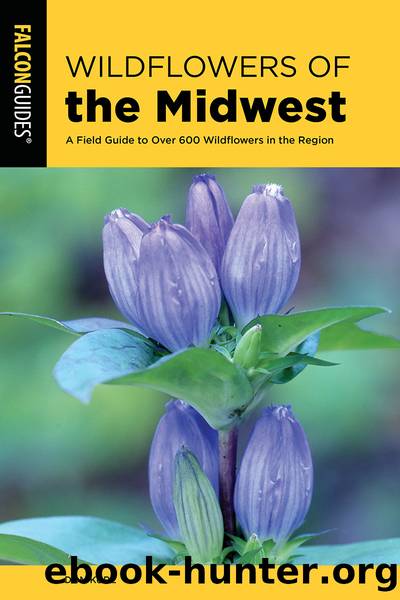WILDFLOWERS OF THE MIDWEST by DON KURZ

Author:DON KURZ
Language: eng
Format: epub
Publisher: FALCONGUIDES
Published: 2020-08-25T00:00:00+00:00
COMMON EVENING PRIMROSE
Oenothera biennis
Evening primrose family (Onagraceae)
Description: A biennial with a stout, sometimes hairy stem tinged with red, as are parts of the older leaves, up to 7' tall. The basal leaves are stalked, 4â12" long and 1â2" wide, and irregularly toothed along the margins. The stem leaves are alternate, lance-shaped, pointed at the tip, hairy on both sides, toothed along the margins, and up to 6" long and 2" wide. The flowers are numerous along a long column that opens to 2½" across. The 4 yellow petals have a shallow notch at the end. There are 8 yellow stamens.
Bloom Season: Summerâfall
Habitat/Range: Common to abundant in disturbed areas in prairies, at the edges of woods, along streams, pastures, fields, and along roadsides; found throughout the Midwest region.
Comments: The flowers open in the evening and close by mid-morning on sunny days. The flowers emit a creosote smell that particularly attracts night-flying sphinx moths. Native Americans ate the seeds and the first-year roots (the second-year roots are too woody). After this plant was introduced to Europe from North America in the early 1600s, Europeans ate its roots and put the young shoots into salads. The entire plant was prepared and used to treat whooping cough, hiccups, and asthma. A closely related species, northern evening primrose (Oenothera parviflora), differs by having gland-tipped hairs along the stem, flowers ¾â1½" across, and flower spikes nodding at the top; found in the northern half of the Midwest region.
Download
This site does not store any files on its server. We only index and link to content provided by other sites. Please contact the content providers to delete copyright contents if any and email us, we'll remove relevant links or contents immediately.
The Lonely City by Olivia Laing(4750)
Animal Frequency by Melissa Alvarez(4395)
All Creatures Great and Small by James Herriot(4233)
Walking by Henry David Thoreau(3894)
Exit West by Mohsin Hamid(3778)
Origin Story: A Big History of Everything by David Christian(3649)
COSMOS by Carl Sagan(3554)
How to Read Water: Clues and Patterns from Puddles to the Sea (Natural Navigation) by Tristan Gooley(3409)
Hedgerow by John Wright(3276)
The Inner Life of Animals by Peter Wohlleben(3259)
How to Read Nature by Tristan Gooley(3249)
How to Do Nothing by Jenny Odell(3232)
Project Animal Farm: An Accidental Journey into the Secret World of Farming and the Truth About Our Food by Sonia Faruqi(3177)
Origin Story by David Christian(3147)
Water by Ian Miller(3128)
A Forest Journey by John Perlin(3027)
The Plant Messiah by Carlos Magdalena(2883)
A Wilder Time by William E. Glassley(2818)
Forests: A Very Short Introduction by Jaboury Ghazoul(2790)
